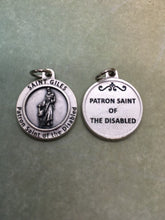St. Giles holy medal
Memorial is September 1.
Born to a wealthy noble family, when his parents died, Giles gave his fortune to help the poor. Known as a miracle worker. To avoid followers and adulation, he left Greece c.683 for France where he lived as a hermit in a cave in the diocese of Nimes, a cave whose mouth was guarded by a thick thorn bush, and a lifestyle so impoverished that, legend says, God sent a deer to Giles to nourish him with her milk.
One day after he had lived there for several years in meditation, a royal hunting party chased the hind into Giles’ cave. One hunter shot an arrow into the thorn bush, hoping to hit the deer, but instead hit Giles in the leg, crippling him. The king sent doctors to care for hermit‘s wound, and though Giles begged to be left alone, the king came often to see him.
From this, Gile’s fame as sage and miracle worker spread, and would-be followers gathered near the cave. The French king, because of his admiration, built the monastery of Saint Gilles du Gard for these followers, and Giles became its first abbot, establishing his own discipline there. A small town grew up around the monastery, and upon Giles’ death, his grave became a shrine and place of pilgrimage; the monastery later became a Benedictine house.
The combination of the town, monastery, shrine and pilgrims led to many handicapped beggars hoping for alms; this and Giles’ insistence that he wished to live outside the walls of the city, and his own damaged leg, led to his patronage of beggars, and to cripples since begging was the only source of income for many. Hospitals and safe houses for the poor, crippled, and leprous were constructed in England and Scotland, and were built so cripples could reach them easily. On their passage to Tyburn for execution, convicts were allowed to stop at Saint Giles’ Hospital where they were presented with a bowl of ale called Saint Giles’ Bowl, “thereof to drink at their pleasure, as their last refreshing in this life.”
In Spain, shepherds consider Giles the protector of rams. It was formerly the custom to wash the rams and colour their wool a bright shade on Giles’ feast day, tie lighted candles to their horns, and bring the animals down the mountain paths to the chapels and churches to have them blessed. Among the Basques, the shepherds come down from the Pyrenees on 1 September, attired in full costume, sheepskin coats, staves, and crooks, to attend Mass with their best rams, an event that marks the beginning of autumn festivals, marked by processions and dancing in the fields. One of the Fourteen Holy Helpers, the only one not to die as a martyr. (info from CatholicSaints.Info » Blog Archive » Saint Giles)
- Catholic saint
- Greek hermit in France. abbot, patron of the disabled, beggars, cancer patients, breast feeding, blacksmiths, epileptics, forests, horses, lepers, the mentally ill, rams, woods. he was a miracle worker in the 7th century.
These medals are great on necklaces, bracelets, rosaries, pins or whatever else you had in mind. They all come with an open jump ring so you can attach it to your necklace.
Get a chain here:
Holy Medal Chains - 18", 24", 30" chains, stainless steel, aluminum, c – chillypumpkinholymedals
All medals and crucifixes are silver oxide (unless noted otherwise), which is a silver plated zinc alloy. **For the longest shine, you may want to coat your silver oxide medals with a clear coat of clear nail polish. The thin coating of silver oxide will eventually wear off.** They are quality Italian made, and the medals are approx. 1 inch tall and 5/8 inch wide.
Your items will ship first class within 1-3 days, in a padded kraft envelope.






